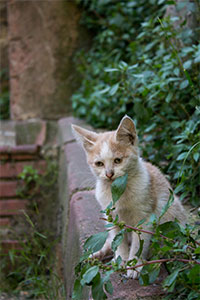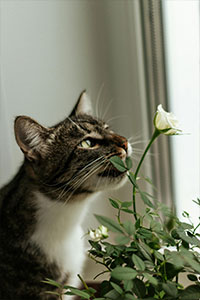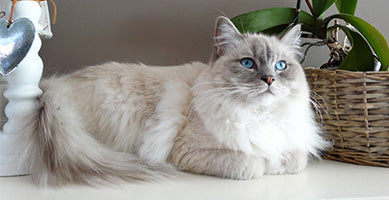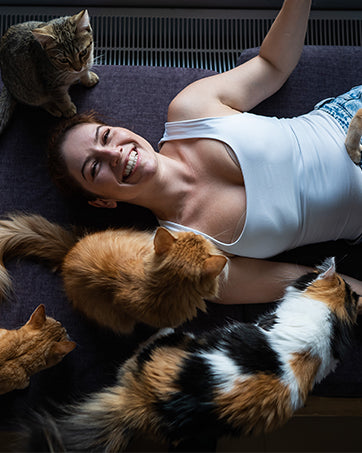Jessica W. Kelvin - Mar.05.2024
Why Do Cats Eat Grass?
7 Insights into Feline Behavior

Written by Vinh Trinh| DVM|4.10.24
What Do Common Cat Sleeping Positions Mean?
Est. read time: 4 min.
HHave you ever found your cat sleeping in a position that couldn’t possibly be comfortable? Find out what specific cat sleeping positions reveal about your cat’s mood, health, and personality—and check out these cozy cat beds while you’re at it.
8 common cat sleeping positions
All curled up
You often see your cat curled up with her tail around her body and her head tucked towards her chest—it’s the quintessential cat pose! This is one of the most common cat sleeping positions, and with good reason: In the wild, animals sleep in this position to conserve warmth while protecting vital organs.

Cat in a box
Cats have some peculiar preferences for where they sit (a piece of paper, anyone?). They generally seek out boxes as an instinct to find cover for hunting, as well as to hide from other predators. Your cat probably equates tight spaces in general with security. You should consider why your cat may be feeling concerned about his safety. For instance, is there a rambunctious pet or a young child in the house?

Belly-up
If you come across your cat in the belly-up position, you should feel honored: Cats generally only sleep this way when they feel extremely relaxed and safe. Your cat’s stomach is her most vulnerable body part, so freely exposing it means she is comfortable enough to give up her most protective instincts.

Half-eye shut
Cats sleep a lot. But the amazing thing about felines is they can simultaneously be awake and asleep, a skill that comes in handy in the wild when they must be alert to their surroundings. If your cat is sleeping with one eye open, one eye closed, chances are he is both sleeping and conscious enough to react to an impending threat.

Loaf
The loaf—where your cat sits upright but tucks her front paws under her body—is a social media favorite among the cat sleeping positions. This adorable pose likely means she isn’t planning to sleep for long, but getting in a quick rest before she moves on with her day.

Sideways sleeper
Like the belly-up pose, a sideways sleeper indicates your cat is very relaxed and in a deep sleep. His vulnerable stomach is somewhat exposed in this position and his limbs are stretched out. He feels safe and content enough not to remain in an alert, shallow sleep.

Paw across the face
Be still, our hearts! When your cat strikes the precious pose of putting her paw across the face, it means she doesn’t wish to be disturbed. The video explains that this usually happens unknowingly while your cat is sleeping soundly. It could also indicate that your cat is trying to block out the daylight or a bright light in the room. Perhaps she needs a kitty sleeping mask!

Monorail cat
One of the most interesting of the cat sleeping positions in the monorail, or when your cat lies on the arms or backs of chairs, sofas, staircase banisters, fence posts (and so on) and dangles down some or all of his legs. Apparently cats rest in this position because it is more suitable for general surveillance.

Now you know what the most common cat sleeping positions mean. Which is your—and your cat’s—favorite?
Make pet care easier and smarter with a self-cleaning litter box.
Cats:Theobromine Toxic Consumption
Most Cats: 1-10 lbs(0.45-4.6 kg), Large Cats11-25 lbs(5-11.4 kg)
Cacao Beans: Most Cats> 0.05 oz, Large Cats> 0.5 0z
Unsweetened Baking Chocolate: Most Cats> 0.2 oz, Large Cats>2 0z
Dark Chocolate: Most Cats> 0.5 0z, Large Cats>7 oz
Milk Chocolate: Most Cats>1.5 0z, Large Cats>16.5 0Z
White Chocolate: Most Cats>360 oz, Large Cats>4000 0z
Cocoa Powder: Most Cats> 01 0z, Large Cats>10z
Cocoa Bean Mulch: Most Cats>0.1 0z, Large Cats>1 0z

Showing making procedure is a good way to guarantee product quality
Stress Relief
Eating grass can also serve as a form of stress relief for cats, providing a calming activity that distracts from anxiety or boredom.


Get customer attention by clean visual and video
Instinctual Actions
Grass eating is an instinctual behavior that may stem from a cat's need to seek out alternative food sources or to induce vomiting to clear their stomachs of indigestible materials.
Article credit: Heidi Cohen (https://heidicohen.com/use-blog-to-sell/)
Digestive Aid
Grass acts as a natural laxative, helping cats pass hairballs or other indigestible items through their digestive tract more easily.
Elimination of Parasites
It's also theorized that grass eating may help cats eliminate intestinal parasites, although this benefit is more anecdotal than scientifically proven.
How to Safely Introduce Grass to Your Cat
Suitable Types of Grass
Certain types of grass are more beneficial and safer for cats, including wheatgrass, which is often sold as "cat grass."
Growing Your Own Cat
Grass
For the safety and health of your cat, consider growing your own cat grass at home. It's a simple and effective way to ensure they're getting a safe product.
Alternative Behaviors and Solutions
Dietary Supplements
If your cat shows an excessive interest in eating grass, it might indicate a dietary deficiency. Consult with a veterinarian about supplementing your cat's diet.
Behavioral Enrichment
Providing toys, climbing structures, and engaging activities can reduce your cat's inclination to eat grass by offering alternative forms of stimulation.
Why Do Cats Eat Grass?
Exploring the curiosity behind this behavior reveals a complex blend of nutritional, psychological, and instinctual factors. Understanding these can help cat owners provide better care and enrichment for their feline friends.
Owner Experiences and Advice
Personal Anecdotes
Many cat owners have observed their pets eating grass and have noted the benefits or concerns that came with it. Sharing these experiences can offer valuable insights for other pet owners.
Expert Recommendations
Veterinarians and animal behaviorists can provide professional advice on managing grass-eating behavior, ensuring it remains a safe and positive experience for your cat.
FAQs
Cats should not eat chocolate ice cream; not only is chocolate toxic to cats, but ice cream often contains toxic ingredient propylene glycol. Ingesting propylene glycol can lead to anemia in cats.
Say it at the end
Understanding why cats eat grass sheds light on their complex behaviors and the natural instincts that drive them. By providing safe, suitable grass and paying attention to the underlying reasons for this behavior, cat owners can ensure their feline companions lead happy, healthy lives.












